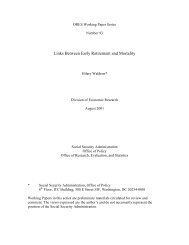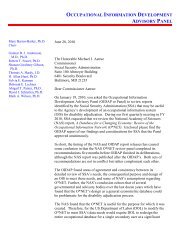Download entire publication - Social Security
Download entire publication - Social Security
Download entire publication - Social Security
Create successful ePaper yourself
Turn your PDF publications into a flip-book with our unique Google optimized e-Paper software.
offset by the elimination of the earnings tests becausethese two policies seem to have affected claimingbehavior in opposite directions around the FRA.One number clearly stands out in Table 1―the largeincrease in the proportion of individuals claimingbenefits at age 66 in 2004; see corresponding numberin Table 2. The percentage claiming at age 66 increasesfrom 1.1 percent to 7.1 percent in a single year. The reasonfor this is that the microdata report differently fromthe Supplement the claiming of benefits at the FRA of65 and 2 months for the cohort who turned 66 in 2004.In the Supplement, those claiming benefits at age 65and 2 months appear to be claiming at age 65, whilein the microdata they appear to be claiming at age 66.This also explains the increasing percentage claimingat age 65 in 2004 as reported in the Supplement, butthe declining percentage claiming at the same age inthe microdata. The advantage of the microdata is thatthey show something that is well-known, but elusive inthis period of changing FRA: A nontrivial number ofindividuals claim benefits exactly when they reach theFRA. 20 Song and Manchester (2007c) present strikingadditional evidence to that effect.Evidence on Level of Benefit ReceiptTable 3 presents the level of average monthly benefitsadapted for the adjustment factors that have changedconsiderably in the period of analysis resulting fromthe policy changes we have discussed. The evolutionof these factors is presented in Table 4 and thenused to obtain the ARF/DRC-adjusted or actuariallyadjusted (and inflation-adjusted by the ConsumerPrice Index, so that the benefit levels are all reportedin 2005 dollars) benefit levels in the remaining tables,discussed later. 21 These adjustments are necessary sothat benefits can now be compared, with the theoryin mind that in the absence of self-selection (whichembeds individual heterogeneity, including for example,differential mortality expectations, health status,and earnings histories), the prediction would be thatthe benefit levels would not change by age, and theywould only change by year because of time and cohorteffects, where the former includes policy changes andmacroeconomic effects. 22In Table 3, we are essentially estimating the averagePIA by age and year for those applying in this period.Our calculation is likely to differ from the actual PIAsfor two reasons. First, in our calculations it is assumedthat individuals claim exactly on their birthdays (orin the month they reached the FRA for claimers whowere 65 in 2003 or later), which means that for thoseclaiming in the months between birthdays, our calculationwill use an ARF that is too small, resulting inan adjusted benefit that is higher than the PIA. Second,the benefit level reported is taking into account theeffect of the earnings test, but because the earningstest is nearly actuarially fair, our adjustment deliversan approximation that is too low compared withthe true PIA. Because these effects move in differentdirections, it is an empirical question whether ourapproximation of the PIA is upward or downwardbiased. We have also used the PIA reported in thepublic-use microdata extract to perform the sameanalysis we present below, and the results are essentiallyunchanged as shown in Tables A-1 and A-2 inthe Appendix. 23 The advantage of what we report hereis that it can be compared by researchers with aggregatedata from the Supplement, which is easily andreadily accessible to researchers but does not providethe PIA.Table 3.Average monthly benefits for retired workers, adjusted by the ARF and the DRC, by age, 1994–2004(in 2005 dollars)Age 1994 1995 1996 1997 1998 1999 2000 2001 2002 2003 200462 1,065.91 1,039.24 1,041.99 1,050.28 1,061.61 1,112.96 1,110.40 1,137.49 1,172.71 1,181.27 1,134.8163 1,041.79 1,070.49 1,045.26 1,043.64 1,058.63 1,057.92 1,105.28 1,104.24 1,123.12 1,157.47 1,110.9964 1,089.06 1,088.86 1,095.24 1,060.10 1,056.50 1,089.29 1,101.26 1,162.92 1,186.47 1,185.22 1,182.0665 1,138.35 1,129.55 1,128.78 1,134.92 1,103.10 1,103.48 1,123.02 1,150.72 1,194.23 1,210.43 1,172.5366 1,190.88 1,080.07 1,137.30 1,090.37 1,146.25 1,161.20 1,224.59 891.68 862.49 977.08 1,134.7867 1,071.46 1,083.73 1,113.53 1,068.67 1,028.65 1,149.16 1,248.28 833.95 878.65 848.13 907.7568 1,030.63 966.00 1,009.15 1,000.26 1,002.91 1,089.51 1,213.70 847.24 748.87 730.58 774.6169 1,173.50 1,171.31 1,012.89 997.81 998.48 1,088.88 1,149.75 873.58 840.28 694.77 838.93SOURCE: Authors' calculations using the OASDI public-use microdata file, 2004.NOTE: Shading is used to emphasize differences by age group.<strong>Social</strong> <strong>Security</strong> Bulletin • Vol. 69 • No. 3 • 2009 83








